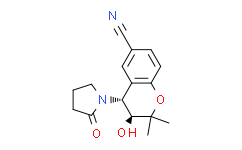Levcromakalim ((-)-Cromakalim) inhibits spontaneous contractions completely in a glibenclamide-sensitive manner. LevCromakalim (5 μM) inhibits spontaneous contractions, which are recovered by glibenclamide. Levcromakalim (1, 5 and 10 μM) inhibits phasic contractions to 34±21.1%, 20.1±20.0% and 0% of the control (n=5, respectively; P<0.05). Glibenclamide reverses the inhibition of spontaneous isometric contractions caused by LevCromakalim (5 μM) to 84±1.5% of the control (n=5; P<0.05). Levcromakalim (20 and 100 μM) also inhibits oxytocin (OXT) (10 nM)-induced phasic contractions to 34±21.4% and 14±12.6% of the control (n=6 and 4, respectively; P<0.05). Glibenclamide reverses the inhibition of spontaneous isometric contractions by LevCromakalim (100 μM) to 79±3.5% of the control (n=4; P<0.05). Tonic contraction by OXT is also suppressed by Cromakalim in a glibenclamide-sensitive manner.The function of the KATP channels is examined with the specific channel opener LevCromakalim (Cromakalim). LevCromakalim induces dose-dependent relaxation in both the young and old mesenteric artery (MAs); and there is no difference in relaxation with age. However, the relaxation is markedly reduced in response to the high-salt (HS) diet in the old MAs (P<0.05). Maximum dilations to Levcromakalim (10 M) are 97 ± 3% in the young MAs versus 98 ± 1% in the young salt arteries, while dilations are 99±0.7% in the old MAs when compared with 85 ± 5% in the old salt arteries (P<0.05).
Medlife has not independently confirmed the accuracy of these methods. They are for reference only.



 扫码关注公众号
扫码关注公众号